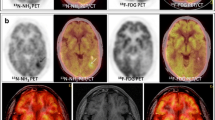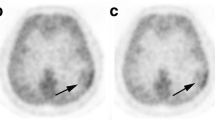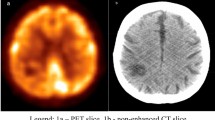Abstract
We investigated the usefulness of 13N-NH3 PET in characterizing brain lesions which show hypometabolism on 18F-FDG PET. 13N-NH3 PET was performed in 18 patients with brain lesions (in 14 for initial diagnosis and in 4 for detection of astrocytoma recurrence) that showed hypometabolism compared with normal brain tissue on 18F-FDG PET. The diagnoses were ten gliomas, one metastatic tumor, one dysembryoplastic neuroepithelial tumor (DNT), and six non-neoplastic lesions (including three cases of radiation necrosis, two cases of encephalitic foci, and one ischemic lesion). Diagnosis was verified by histopathological examination in 13 patients or was established by clinical follow-up and additional investigations in the remainder. Seven of 12 brain tumors (58%, sensitivity) showed increased 13N-NH3 uptake despite hypometabolism on 18F-FDG PET. The three low-grade gliomas, one metastatic tumor, and one DNT showed decreased 13N-NH3 uptake. The mean (±SD) uptake ratio of 13N-NH3 was significantly higher than that of 18F-FDG (1.24 ± 0.57 vs. 0.67 ± 0.21, P < 0.01) in the tumors. By contrast, all six non-neoplastic lesions showed decreased 13N-NH3 uptake (100% specificity). The mean (±SD) uptake ratio of 18F-FDG and 13N-NH3 in the non-neoplastic lesions was 0.68 ± 0.15 and 0.70 ± 0.19, respectively, and there was no significant difference between them (P > 0.05). The mean (±SD) uptake ratio of 13N-NH3 in the tumors was significantly higher than that in the non-neoplastic lesions (1.24 ± 0.53 vs. 0.70 ± 0.19, P < 0.05). The preliminary results of this study suggest that 13N-NH3 PET may be helpful to detect and differentiate brain tumors which show hypometabolism on 18F-FDG PET from non-neoplastic lesions with high specificity, especially for cerebral astrocytomas, but the sensitivity is relatively limited.



Similar content being viewed by others
References
Chung JK, Kim YK, Kim SK et al (2002) Usefulness of 11C-methionine PET in the evaluation of brain lesions that are hypo- or iso-metabolic on 18F-FDG PET. Eur J Nucl Med 29:176–182
Roelcke U, Radu EW, von Ammon K et al (1995) Alteration of blood-brain barrier in human brain tumors: comparison of [18F]fluorodeoxyglucose, [11C]methionine and rubidium-82 using PET. J Neurol Sci 132:20–27
Ogawa T, Shishido F, Kanno I et al (1993) Cerebral glioma: evaluation with methionine PET. Radiology 186:45–53
Schelbert HR, Phelps ME, Huang SC et al (1981) N-13 ammonia as an indicator of myocardial blood flow. Circulation 63:1259–1272
Phelps ME, Huang SC, Hoffman EJ et al (1981) Cerebral extraction of N-13 ammonia: its dependence on cerebral blood flow and capillary permeability-surface area product. Stroke 12:607–619
Xiangsong Z, Changhong L, Weian C et al (2006) PET imaging of cerebral astrocytoma with 13N-ammonia. J Neurooncol 78:145–151
Xiangsong Z, Xinjian W, Yong Z et al (2008) 13N-NH3: a selective contrast-enhancing tracer for brain tumor. Nucl Med Commun 29:1052–1058
Cooper AJ, Plum F (1987) Biochemistry and physiology of brain ammonia. Physiol Rev 67:440–519
Raichle ME, Larson KB (1981) The significance of the NH3–NH+(4) equilibrium on the passage of 13N-ammonia from blood to brain. A new regional residue detection model. Circ Res 48:913–937
Ott P, Larsen FS (2004) Blood-brain barrier permeability to ammonia in liver failure: a critical reappraisal. Neurochem Int 44:185–198
Cooper AJL, McDonald JM, Gelbard AS et al (1979) The metabolic fate of 13N-labeled ammonia in rat brain. J Biol Chem 254:4982–4992
Fucci L, Oliver CN, Coon MF et al (1983) Inactivation of key metabolic enzymes by mixed-function oxidation reactions: possible implication in protein turnover and ageing. Proc Natl Acad Sci USA 80:1521–1525
Ishii K, Ogawa T, Hatazawa J et al (1993) High L-methyl-[11C]methionine uptake in brain abscess: a PET study. J Comput Assist Tomogr 17:660–661
Tashima T, Morioka T, Nishio S et al (1998) Delayed cerebral radionecrosis with a high uptake of 11C-methionine on positron emission tomography and 201Tl-chloride on single-photon emission computed tomography. Neuroradiology 40:435–438
Jacobs A (1995) Amino acid uptake in ischemically compromised brain tissue. Stroke 26:2175–2179
Acknowledgment
This study was partially supported by grant 07001640 from the Nature Sciences Foundation of Guangdong Province, and grant 20070558245 from Foundation for New Teacher for Higher Education, Ministry of Education, China.
Author information
Authors and Affiliations
Corresponding author
Rights and permissions
About this article
Cite this article
Xiangsong, Z., Weian, C., Dianchao, Y. et al. Usefulness of 13N-NH3 PET in the evaluation of brain lesions that are hypometabolic on 18F-FDG PET. J Neurooncol 105, 103–107 (2011). https://doi.org/10.1007/s11060-011-0570-0
Received:
Accepted:
Published:
Issue Date:
DOI: https://doi.org/10.1007/s11060-011-0570-0




